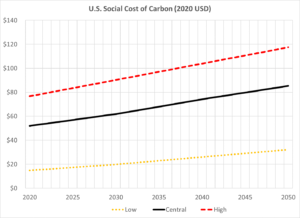Autocase’s full carbon story is shown in some interesting graphs.
The social cost of carbon represents, in dollar terms, the future climate change-related damages (to health, crops, buildings etc.) due to an additional metric tonne of carbon dioxide equivalent (or CO2e) emitted into the atmosphere.
We are often asked about how we calculate the social cost of carbon.
The short answer is, we don’t.
We let the experts do the hard work and keep tabs on the range of values out there from the peer-reviewed literature. Values typically range from $30-$100 USD* and you can now see the range of values for carbon in the tool itself.

*These are marginal abatement costs to reach global warming targets.
The default value in Autocase comes from the U.S. Interagency Working Group (IWG) on the social cost of carbon and the value is $51.94 USD per metric tonne in 2020 (and is rising over time).

Like all inputs in Autocase we provide a default but let you override the input if you wish. You can enter you value, and see the range of studies in the advanced inputs under the social cost tab.
Autocase software users can see the full carbon story of their building project. Autocase gives you the carbon emissions saved from:
- The embodied carbon (extraction, processing, transport, and disposal) of material choices and lower carbon materials options
- The operational carbon from energy and water efficiency initiatives from features such as various HVAC options;
- The operational carbon from renewable energy production; and,
- The carbon sequestration in green roofs and other green infrastructure initiatives;
- The operational carbon from rainwater harvesting and greywater reuse.
The video shows some of the carbon story outputs:
Stay tuned for new features related to the full carbon story such as energy storage and the cost of solar panels.
A note on the range associated with the social cost of carbon (SCC) shown in the graph above. The SCC has a large range and we use the mid-point of set of consensus values. “Sophisticated climatic and economic models have been developed in the academic community that draw on economic and scientific knowledge to estimate the SCC. However, given that the models forecast both natural and economic outcomes centuries into the future, there is inherent uncertainty associated with the estimates, and a wide range of SCC values are reported in the literature.” We use the U.S. Interagency Working Group estimates and they relied on “three peer-reviewed, global, integrated assessment models developed by leading academic experts in the field to produce estimates of the SCC. The U.S. Working Group chose to develop four different sets of values to reflect uncertainty with respect to the discount rate, which determines how future costs are valued today, and the risk of severe catastrophes under low-probability scenarios. The SCC values increase over time, as emissions accumulate in the atmosphere and the cost associated with an additional tonne of CO2 emissions increases.” The high and low values that come from these models and scenarios are plausible and accepted estimates and do represent a lot of uncertainty. As mentioned, we use the middle estimate of three provided. To put the range into perspective, even for tangible commodities used on building such as steel and concrete, because they may be imported, subject to large price swings, tariffs, exchange rates, labor disputes, etc. they too are subject to uncertainty. And so early in a building project, before contracts lock these prices in these items may be subject to big ranges in the cost estimates. AACE International’s Cost Estimate Classification System recommends for example at the concept screening phase costs be (relative to the best guess) Low: -20% to -50% to High: +30% to +100%.” In this context a SCC (in 2020) of $52 with a low of $15 (-28%) and a high of $77 (+48%) does not seem quite so large. We think we have captured the reasonable value and ranges for the SCC but if you have suggestions on studies that would help us with better estimates of the SCC, please let us know. (Quotes from: Technical Update to Environment and Climate Change Canada’s Social Cost of Greenhouse Gas Estimates March 2016 by Environment and Climate Change Canada)
0 Comments